
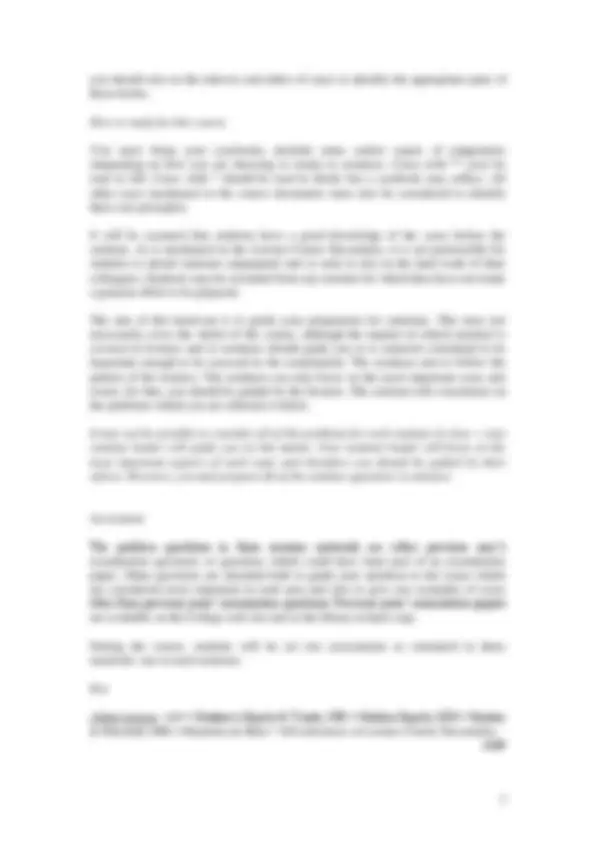
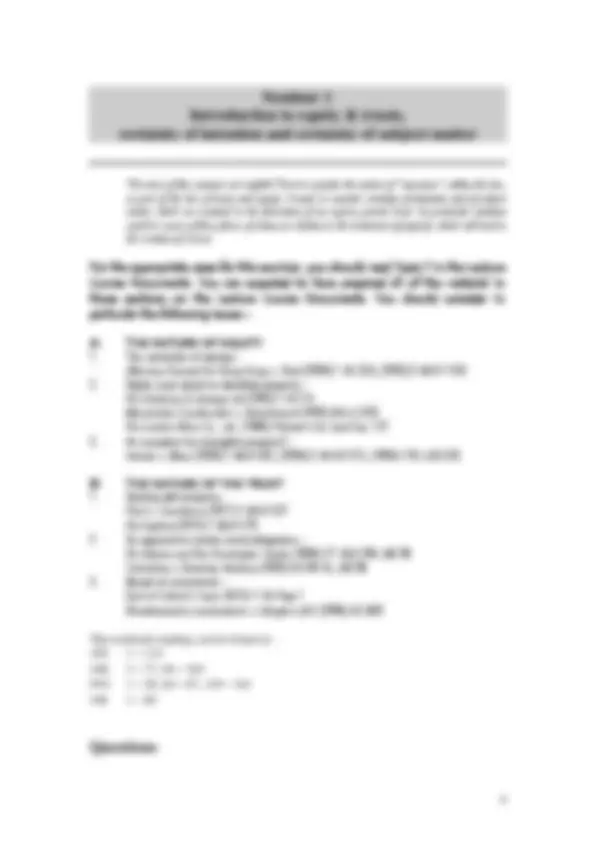
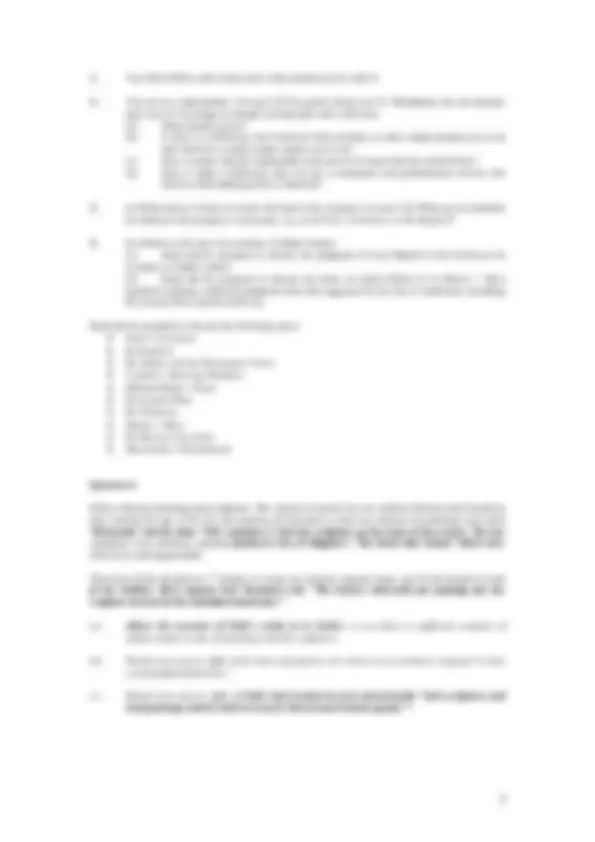
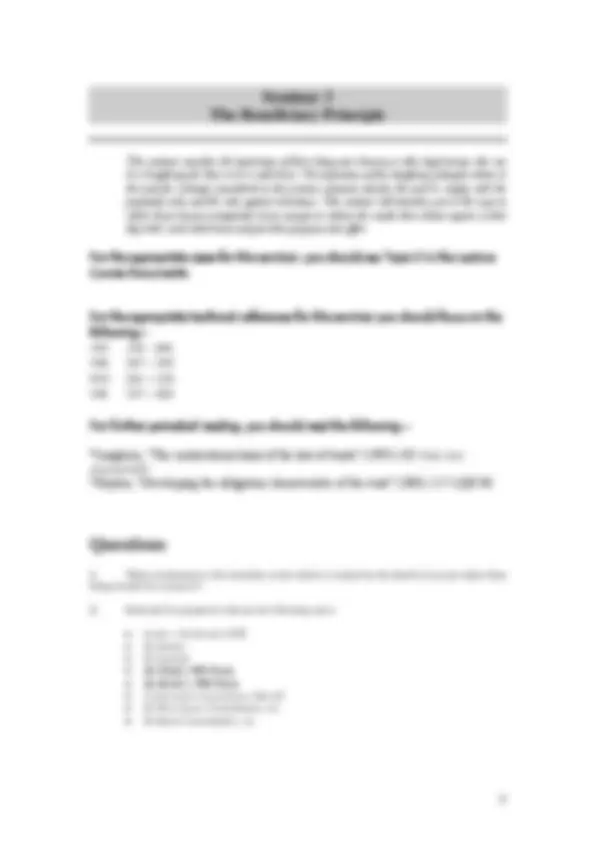
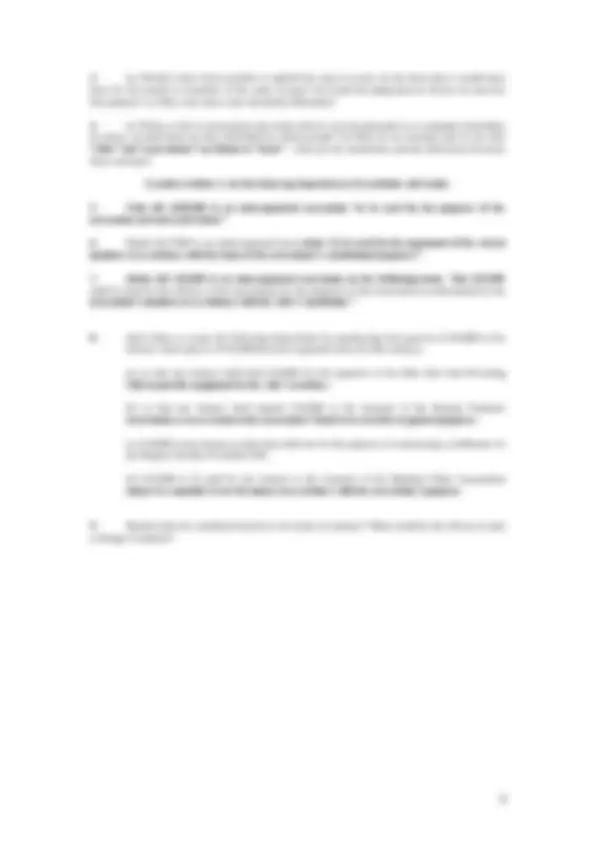
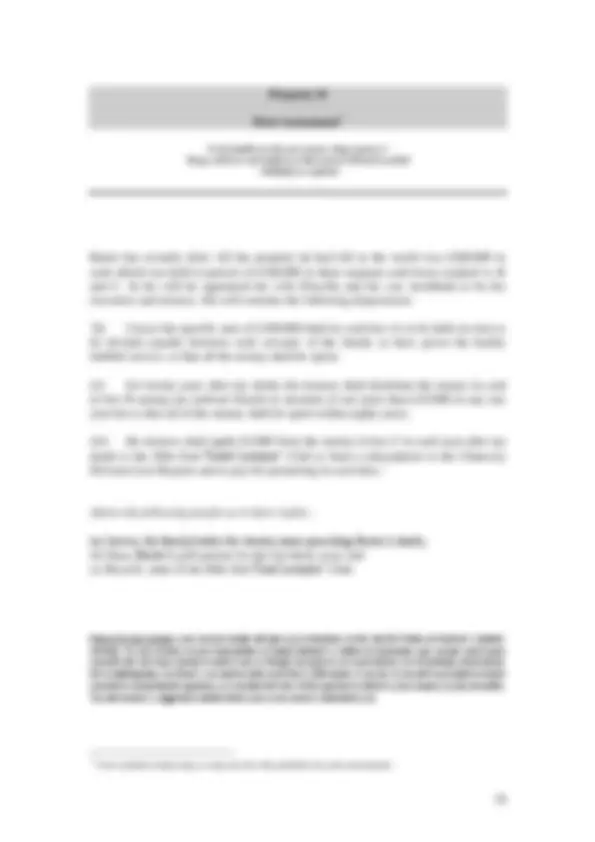
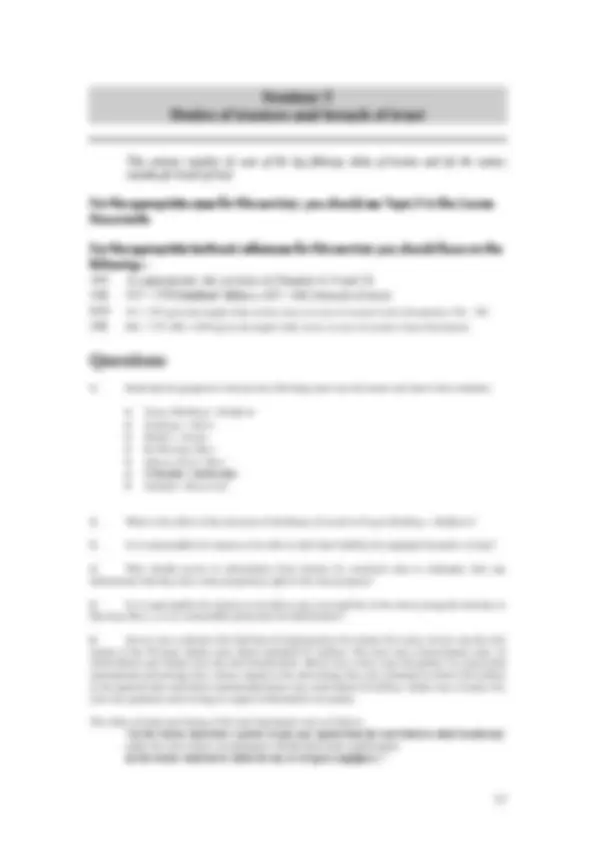
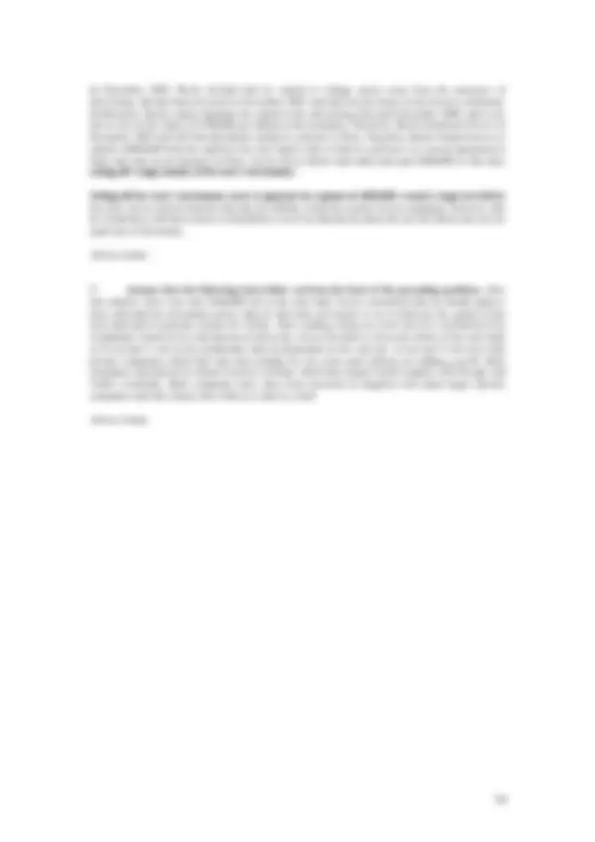
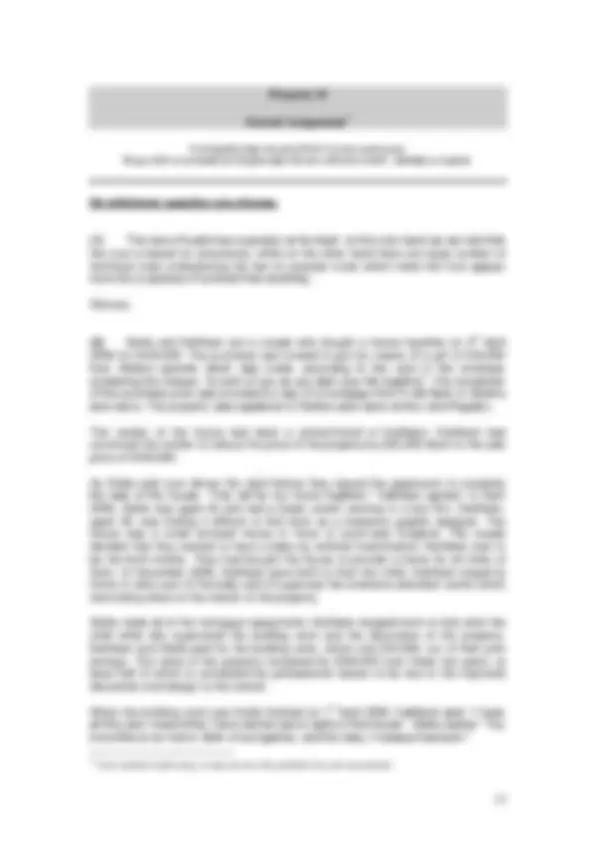
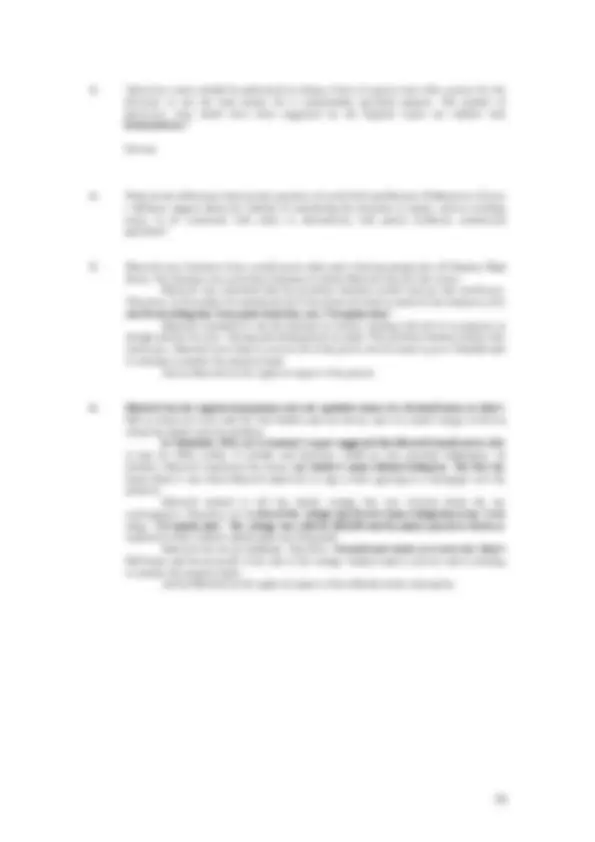
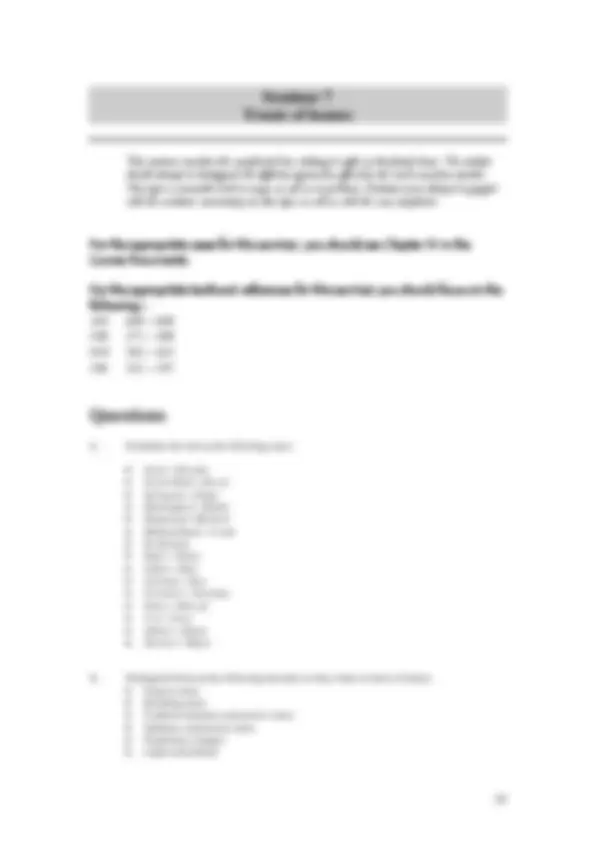
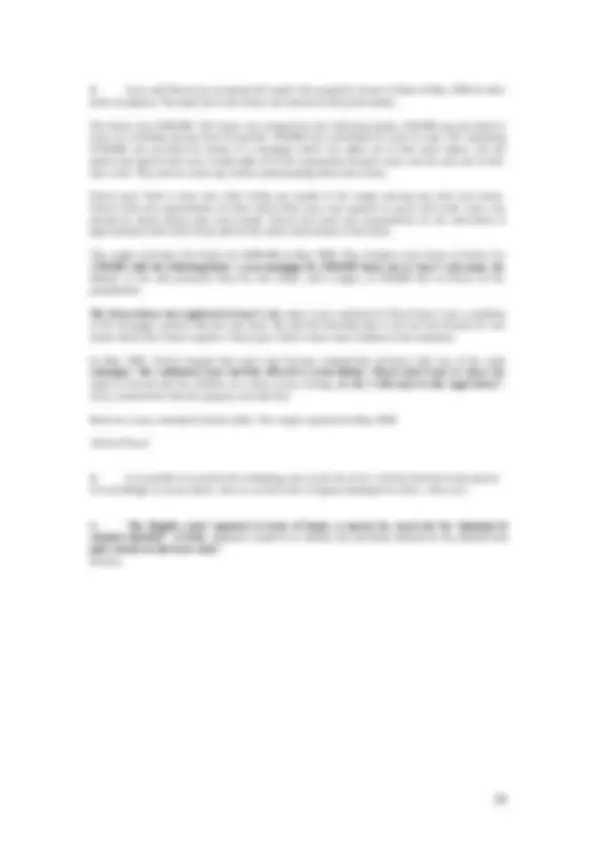
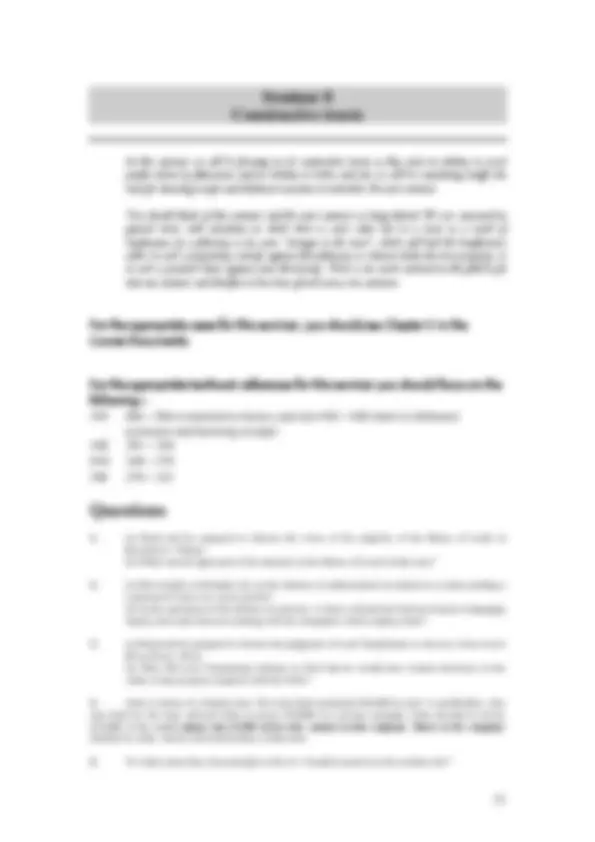
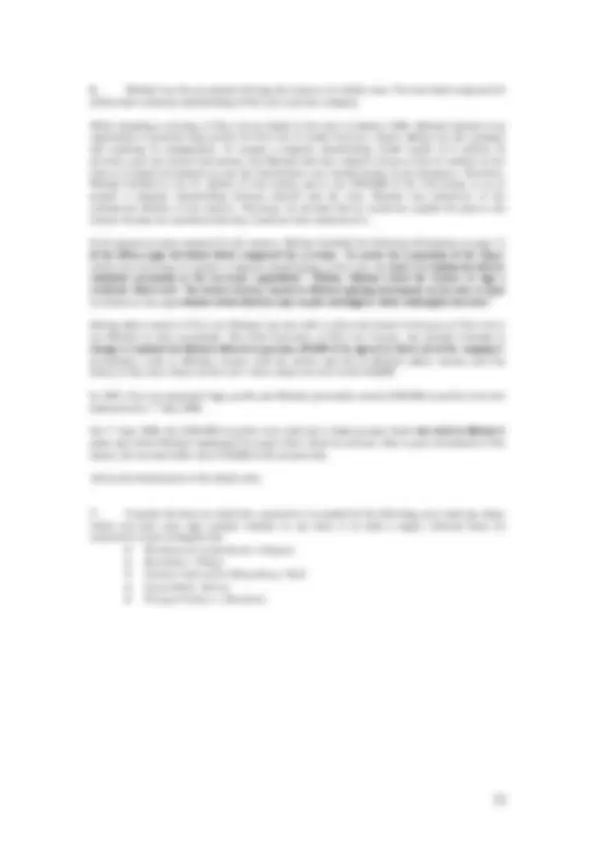
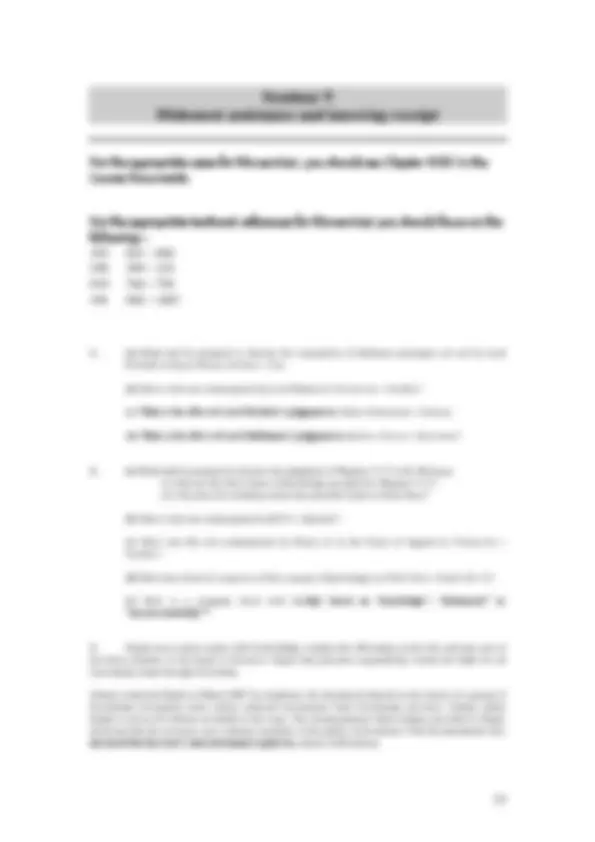
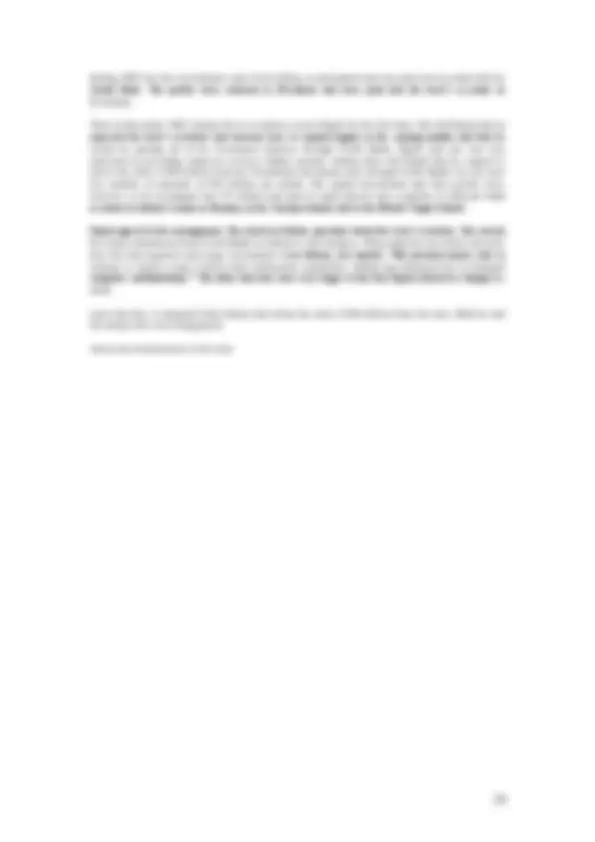
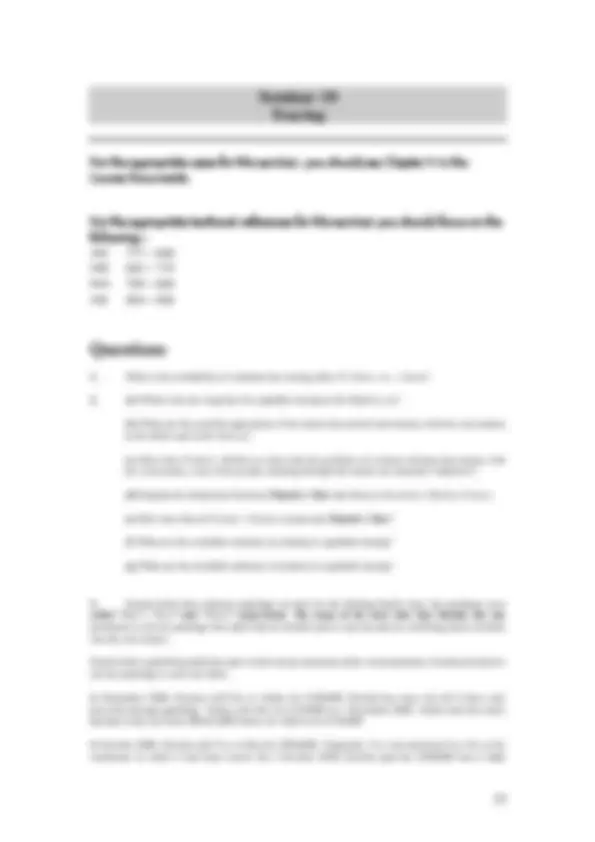
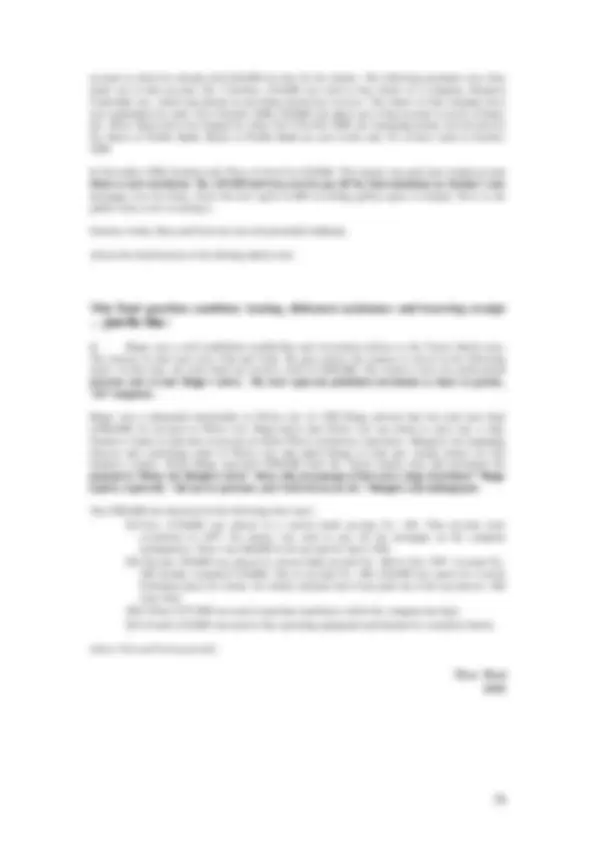


Study with the several resources on Docsity

Earn points by helping other students or get them with a premium plan


Prepare for your exams
Study with the several resources on Docsity

Earn points to download
Earn points by helping other students or get them with a premium plan
Community
Ask the community for help and clear up your study doubts
Discover the best universities in your country according to Docsity users
Free resources
Download our free guides on studying techniques, anxiety management strategies, and thesis advice from Docsity tutors
Materials for a seminar on the law of trusts and equity, focusing on the duties of trustees, breach of trust, and remedies. It includes references to Hudson's textbook and other resources, case readings, and questions for discussion. The seminar also introduces techniques used by trusts lawyers to avoid rules of trusts law.
Typology: Exercises
1 / 26

This page cannot be seen from the preview
Don't miss anything!



















1. You find £100 in cash in the street: what should you do with it? 2. You are in a supermarket. You pay £10 for goods which cost £7. Mistakenly, the till operator pays you £13 in change as though you had paid with a £20 note. (a) What should you do? (b) Is there is a difference here between what morality or ethics might prompt you to do and what law or equity might require you to do? (c) Does it matter that the supermarket sold you £3 of rotten fruit the week before? (d) Does it make a difference that you are a communist anti-globalisation activist who believes that making profits is immoral? 3. (a) What action or form of words will lead to the creation of a trust? (b) What sort of intention in relation to the property is necessary, e.g. as in Paul v Constance or Re Kayford? 4. In relation to the cases on certainty of subject matter: (a) Read and be prepared to discuss the judgment of Lord Mustill in Re Goldcorp for certainty of subject matter. (b) Read and be prepared to discuss the basis on which Dillon LJ in Hunter v Moss justified reaching a different judgment from that suggested by the line of authorities including Re London Wine and Re Goldcorp.
Read and be prepared to discuss the following cases: Paul v Constance Re Kayford Re Adams and the Kensington Vestry Comisky v Bowring-Hanbury Midland Bank v Wyatt Re London Wine Re Goldcorp Hunter v Moss Re Harvard Securities MacJordan v Brookmount
Question 6
Dolly collected paintings and sculptures. She wanted to benefit her two children Edward and Fenella as they reached the age of 50. For this purpose she decided to settle two abstract oil paintings (one titled “Pretension” and the other “Self-importance”) and two sculptures on the terms of these trusts. The two sculptures were identical, machine-produced casts of Magritte‟s “The Head with Clouds” which were effectively indistinguishable.
Therefore, Dolly decided on 1st^ January to create two entirely separate trusts: one for the benefit of each of her children. Each separate trust document read: “The trustees shall hold one painting and one sculpture on trust for the individual beneficiary.”
(a) Advise the executors of Dolly’s estate as to whether or not there is sufficient certainty of subject matter in the oil paintings and the sculptures.
(b) Would your answer differ if the items of property were shares in an ordinary company? Is that a meaningful distinction?
(c) Would your answer differ if Dolly had created one trust and provided “both sculptures and both paintings shall be held on trust for Edward and Fenella equally”?
5. Deborah declared her intention to settle £50,000 “to be held on trust for my relatives equally”. 6. Jack wishes to create the following dispositions by transferring four parcels of £10,000 to his trustees. Each parcel of £10,000 has been separated from all other moneys.
(a) so that my trustees shall hold £10,000 for whichever of my relatives they shall consider to be most deserving of it;
(b) so that my trustees may pay £10,000 to any of my most loyal customers which they may select, but so that the money shall be spent within eighty years;
(c) £10,000 so that my trustees may pay any amount out of that fund to whichever of the inhabitants of east London they shall consider to be the most hard-working; such that the trustees may decide on the application of this money in their personal discretion.
(d) £10,000 to my trustees so that they shall divide it as they shall see fit between my close friends whom they may consider to be most deserving of it.
1. What circumstances will constitute a trust which is created for the benefit of people rather than being invalid for a purpose? 2. Read and be prepared to discuss the following cases:
Leahy v Att-Gen for NSW Re Denley Re Lipinski Re Grant’s Will Trusts Re Recher’s Will Trusts Conservative Association v Burrell Re West Sussex Constabulary, etc. Re Bucks Constabulary, etc.
1
To be handed in at the next seminar, being Seminar 4. Essays which are not handed in at that seminar will not be marked
- absolutely no exceptions.
Format of your answer, your seminar leader will give you instructions on this but for Professor Hudson’s students certainly: (i) your answer can be hand-written or typed (indeed it is better to hand-write your answer and to give yourself only one hour actually to write it out as though you were in an examination); (ii) no footnotes whatsoever; (iii) no bibliography; (iv) there is no need to write more than 2,500 words, if you do so you will have failed to restrict yourself to answering the question; (v) consider the facts of the question in detail in your answer; (vi) do not waffle. You will receive a suggested solution when your assessment is returned to you.
(^1) Your seminar leader may or may not use this problem for your assessment.
This seminar aims to introduce you to some more of the techniques (building on the last seminar) which trusts lawyers use to avoid rules of trusts law. By the end of this seminar you should be able to analyse sets of facts so that you can differentiate between the effect of the various analyses considered in the cases to those sets of facts. First, this seminar considers a complex stream of cases arising out of complex tax avoidance schemes constructed to avoid s.53(1)(c) LPA. This seminar is an important gateway for you into the way in which trusts lawyers manipulate trusts law principles for their commercial ends. What is essential is that you consider the reasons why the court decides whether or not the parties’ actions fall within or without s.53(1)(c) LPA and further how you can use these cases to avoid the result in Grey v. IRC.. Secondly, we will consider the forms of activity which will, or which will not, lead to the creation of a valid express trust. Students will be expected to understand the occasionally narrow distinctions between the cases. Remember, the most important thing is to remember the reasons why a court has upheld, or invalidated, a trust in certain circumstances.
1. When will a disposition fall within s.53(1)(c)? How can the rule in Grey v. IRC be eluded by using the following cases and what are the alternative analyses accepted in those cases:- Vandervell v. IRC Oughtred v IRC and Neville v Wilson
Cohen and Moore v IRC?
2. How do the following cases qualify the rule in Milroy v Lord? Re Rose Pennington v Waine 3. Analyse the following dealings with property in relation to the cases on s.53(1) LPA 1925.
a) Timothy is absolute owner of shares. Timothy declares himself to be trustee of the shares for Arnold.
1. Read and be prepared to discuss the following cases (on the issues relevant to this seminar):
Target Holdings v Redferns Armitage v Nurse Walker v Stones Re Hastings-Bass Abacus Trust v Barr O’Rourke v Derbyshire Schmidt v Rosewood
2. What is the effect of the decision of the House of Lords in Target Holdings v Redferns? 3. Is it conscionable for trustees to be able to limit their liability for negligent breaches of trust? 4. Why should access to information from trustees be restricted only to claimants who can demonstrate that they have some proprietary right in the trust property? 5. Is it conscionable for trustees to be able to get a second bite of the cherry using the doctrine in Hastings-Bass , or is it a reasonable protection for beneficiaries? 6. Jeeves was a solicitor who had been in legal practice for twenty-five years. Jeeves was the sole trustee of the Wooster family trust which contained £1 million. The trust was a discretionary trust, of which Bertie and Arthur were the only beneficiaries. Bertie was a forty year-old partner in a successful international advertising firm, whose capital in the advertising firm was estimated at about £10 million at the material time and whose matrimonial home was worth about £5 million. Arthur was a twenty-five year-old, penniless artist living in a squat in Shoreditch in London.
The other relevant provisions of the trust instrument were as follows: “(a) the trustee shall have a power to pay any capital from the trust fund to either beneficiary under the trust if their circumstances should deteriorate significantly; (b) the trustee shall not be liable for any act of gross negligence.”
In December 2007, Bertie decided that he wanted to change career away from the pressures of advertising. He had been divorced in November 2007 and had lost the house in the divorce settlement. Furthermore, Bertie cannot liquidate his capital in the advertising firm until December 2009, and so he has to rely on his salary of £100,000 per annum in the meantime. Therefore, Bertie telephoned Jeeves in December 2007 and told him that Bertie wanted to relocate to Paris. Therefore, Bertie wanted Jeeves to transfer £600,000 from the capital of the trust fund to him so that he could use it to rent an apartment in Paris and start an art business in Paris. Jeeves did as Bertie had asked and paid £600,000 to him after selling off a large number of the trust‟s investments.
Selling off the trust‟s investments assets to generate the amount of £600,000 created a large tax bill for the trust. Jeeves had not known that this tax liability would be created. Jeeves maintains, however, that he would have sold these assets to help Bertie even if he had known about the tax bill. Bertie has not yet spent any of the money.
Advise Arthur.
7. Assume that the following facts follow on from the facts of the preceding problem. After this transfer, there was only £400,000 left in the trust fund. Jeeves considered that he should adopt a more adventurous investment policy than he had done previously so as to build up the capital in the trust fund and to generate income for Arthur. After reading a blog on a web-site by a well-known City stockbroker whom Jeeves had known at university, Jeeves decided to invest the whole of the trust fund in X Ltd and Y Ltd as the stockbroker had recommended on the web-site. X Ltd and Y Ltd were both private companies which had only been trading for two years each without yet making a profit. Both companies specialised in internet browser software which they hoped would compete with Google and Yahoo eventually. Both companies have since been involved in litigation with much larger internet companies and their shares have fallen in value by a half.
Advise Arthur.
Format of your answer, your seminar leader will give you instructions on this but for Professor Hudson’s students certainly: (i) your answer can be hand-written or typed, it is better to hand-write your answer and to give yourself only one hour actually to write it out as though you were in an examination; (ii) no footnotes whatsoever; (iii) no bibliography; (iv) there is no need to write more than 2,500 words, if you do so you will have failed to restrict yourself to answering the question; (v) consider the facts of the question in detail in your answer; (vi) do not waffle. You will receive a suggested solution when your assessment is returned to you.
1. Read and be prepared to discuss the following cases:
Westdeutsche Landesbank v Islington (Lord Browne-Wilkinson, resulting trusts only) Barclays Bank v Quistclose Carreras Rothmans v. Freeman Mathews Treasure Ltd Twinsectra v Yardley (the speech of Lord Millett only) Templeton Insurance Ltd v Penningtons Solicitors LLP Re Farepak Food and Gifts Ltd
2. “ Quistclose trusts are not limited to one form or another. Instead, the term „ Quistclose trust‟ is a blanket term for a range of techniques used by banks to take security for loans. Consequently, it comes as no surprise that no single explanation of how Quistclose trusts work is wholly satisfying.”
Discuss.
1. Formulate the tests in the following cases:
Stack v Dowden Lloyds Bank v Rosset Springette v Dafoe Huntingford v Hobbs Hammond v Mitchell Midland Bank v Cooke Re Basham Baker v Baker Gillett v Holt Jennings v Rice Lissimore v Downing Oxley v Hiscock Cox v Jones Abbott v Abbott Thorner v Major
2. Distinguish between the following doctrines as they relate to trusts of homes: Express trusts Resulting trusts Common intention constructive trusts Ordinary constructive trusts Proprietary estoppel Unjust enrichment
3. Larry and Cheryl are an unmarried couple who acquired a house in Kent in May 1996 for their joint occupation. The legal title in the house was entered in their joint names.
The house cost £300,000. The house was acquired by the following means. £20,000 was provided to Larry as a birthday present from his parents. £30,000 was contributed by Larry in cash. The remaining £250,000 was provided by means of a mortgage which was taken out in their joint names, but the parties had agreed that Larry would make all of the repayments because Larry was the only one in full- time work. They did not reach any further understanding about their home.
Cheryl gave birth to their first child within one month of the couple moving into their first house. Cheryl took sole responsibility for their child while Larry was required to travel with work. Larry was abroad for about fifteen days each month. Cheryl also took sole responsibility for the renovation of approximately half of the house and for the entire redecoration of the house.
The couple sold their first house for £600,000 in May 2000. They bought a new house in Sussex for £700,000 with the following funds: a new mortgage for £300,000 taken out in Larry‟s sole name; the balance of the sale proceeds from the first house; and a legacy of £50,000 left to Cheryl by her grandmother.
The Sussex house was registered in Larry‟s sole name. Larry explained to Cheryl that it was a condition of the mortgage contract that this was done. He said this knowing that it was not true because he was unsure about their future together. Cheryl gave birth to three more children in the meantime.
In May 2007, Cheryl learned that Larry had become romantically involved with one of his work colleagues. She confronted Larry and they effected a reconciliation. Cheryl asked Larry to “place the rights of herself and the children on a more secure footing, or else I will need to take legal advice”. Larry reassured her that the property was half hers.
However, Larry continued with his affair. The couple separated in May 2008.
Advise Cheryl.
4. Is it possible to reconcile the remaining cases in the list in Q.1 with the decision in the speech of Lord Bridge in Lloyds Bank v Rosset , as the Court of Appeal attempted in Oxley v Hiscock? 5. „The English courts‟ approach to trusts of homes is merely the search for the “phantom of common intention”. A better approach would be to identify the detriment suffered by the plaintiff and make awards on that basis alone.‟ Discuss.